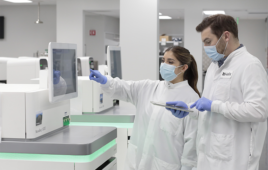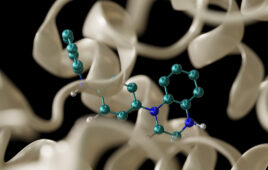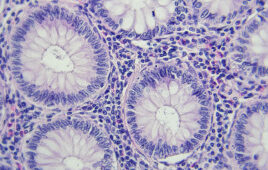Newer formulations and alternative technologies can help overcome the drawbacks of Coomassie protein visualization in PAGE gels.
Electrophoretic analysis is one of the most widely used tools for the determination of protein identification, purity, and integrity. One of the keys to the early development of this ubiquitous tool was the availability of a sensitive and reliable method of visualizing proteins after polyacrylamide gel electrophoresis (PAGE). Over time, Coomassie Brilliant Blue staining has become the most widely accepted method for detecting proteins in gels.
Coomassie R-250, and its dimethylated derivative G-250, have been used as protein gel stains for more than 45 years.1 Improvements over the years have increased sensitivity, and Coomassie staining is compatible with downstream analysis by mass spectrometry (MS). The relatively low cost of these dyes, their ready-made solutions, sensitivity in the five to 50 ng range, detection using standard white light transilluminators, and time-tested staining and destaining protocols, have been keys to their wide acceptance.
Although widely used, Coomassie is not the ideal staining technique for protein band visualization in PAGE. The mechanism by which Coomassie stain binds to proteins is not well understood. Coomassie has long been known to vary widely in its ability to bind proteins, due—at least in part—to its affinity for proteins rich in basic amino acids such as arginine, histidine, and lysine.2 In addition, glycoproteins stain poorly with Coomassie dye,3-5 and there is at least one report in the literature that Coomassie staining may overstate relative protein quantities in gels.6 The user-dependent nature of the process can introduce variability when comparing results generated by different users. Finally, gel staining with Coomassie takes at least two hours, can generate large quantities of hazardous solvents, and is not compatible with subsequent Western blotting.
Improved formulations
Over the years, ready-made solutions have been developed that address two of the key complaints with Coomassie: hazardous or smelly solvents, and time to result. Traditional protocols call for the use of methanol and acetic acid for fixing and de-staining. Commercially available products, such as Bio-Safe (Bio-Rad, Hercules, Calif.) or SimplyBlue (Invitrogen, Carlsbad, Calif.), provide equivalent performance to traditional formulations without the use of methanol or acetic acid, and produce no hazardous waste. Using Imperial Protein Stain (Thermo Fisher Scientific, Rockford, Ill.), an improved formulation of Coomassie R-250, as little as 6 ng of protein can be detected in just 20 minutes, without the use of methanol or acetic acid. These commercial formulations can also reduce the number of steps in the staining-de-staining process; thus, reducing hands-on time and user-to-user variability. Microwave protocols are also available for both the traditional and newer formulations, and can reduce the total processing time to an hour or less.
|
Increased sensitivity
There has been an increasing need for higher sensitivity of protein detection in PAGE gels than Coomassie staining can provide, particularly with the advent of proteomics and 2-D SDS-PAGE analysis of complex protein mixtures. The first technique to address this need was silver staining, which can provide detection of as little as 0.25 to 0.5 ng of protein without requiring alternative imaging equipment. The Dodeca Silver Stain kit (Bio-Rad) provides for high-throughput staining, and the SilverQuest Silver Staining Kit (Invitrogen) provides results in less than 90 minutes, or 30 minutes using the microwave procedure. Both are compatible with subsequent mass spectrometry analysis. However, silver-staining methods tend to be very dependent on user technique.
Fluorescent-staining methodologies that routinely extend sensitivity into the 1 ng range and expand the dynamic range of detection have been developed. Perhaps the most widely used is Sypro Ruby (Invitrogen), which has a linear quantitation range of three orders of magnitude. Flamingo (Bio-Rad) provides sensitivity to 0.5 ng and below, and uses a two-step protocol, while Deep Purple (GE Healthcare Life Sciences, Piscataway, NJ) delivers low background fluorescence and no background speckling. All of these fluorescent stains are compatible with subsequent mass spectrometry analysis, but they require at least a UV transilluminator, and work best with laser scanners. The cost per gel is also significantly higher than that of Coomassie stains.
Increased functionality
Coomassie is a general protein stain, as it cannot distinguish one class of proteins—such as phosphorylated proteins—from another class, such as glycoproteins. The Pro-Q Diamond and Emerald series of fluorescent stains from Invitrogen do just that. Diamond phosphoprotein gel stain selectively stains proteins with phosphate groups attached to tyrosine, serine, or threonine residues, using a simple staining protocol that delivers results in four to five hours. This stain is compatible with mass spectrometry, and allows detection of as little as one–16 ng of phosphoprotein per band. Used in combination with Sypro Ruby, it is possible to distinguish a lightly phosphorylated, high-abundance protein from a heavily phosphorylated, low-abundance protein. Emerald glycoprotein stain can also be used in combination with Sypro Ruby to identify those proteins on a gel containing glycans.
|
An alternative imaging technology
A protein visualization technique utilizing a trihalocompound modification of tryptophan7-8 addresses four of the key shortcomings of Coomassie staining: time to result, user-to-user variability, hazardous and smelly solutions, and incompatibility with Western blotting. The technique uses standard sample preparation, reagents, and electrophoresis protocols, with the trihalocompound incorporated into standard gel formulations. After electrophoresis, the gel is subjected to UV irradiation, activating a covalent reaction between the trihalocompound and tryptophan residues on the proteins in the gel. The resultant tryptophan adduct fluoresces when excited by the same UV source. This visualization technique lends itself well to automation, as embodied in the Criterion Stain Free Gel Imaging System (Bio-Rad). The gel is irradiated for as little as 2.5 minutes, and the fluorescent signal is then acquired in less than a few seconds by a detector, producing a digital image of proteins in the gel. The molecular weight and quantity of each protein band are then calculated automatically. The entire electrophoretic separation and gel imaging can be completed in about an hour.
Reproducible quantitation of protein PAGE bands is dependent on the quality and user-to-user reliability of the detection method. Uneven Coomassie staining of gels can result in erroneous quantitation of the protein bands, while gels imaged with this UV irradiation technique have a uniform and low background level and yield reproducible results (Figure 1, page 30). Sensitivity of detection is comparable or superior to Coomassie for many proteins (limit of detection 0.2 to 5 ng). The Criterion Stain Free system demonstrated a coefficient of variation (CV) of only 7.8% in one study, while Coomassie quantitation gave a CV of 19.7%.8
This UV irradiation technique is valid for most proteins, since less than 10% of the proteins from 10-260 kD in most organisms lack tryptophan. In fact, only 7.3% of human proteins larger than 10 kD lack tryptophan.9 The UV activation imaging method can be used with a variety of complex protein samples from a number of sources, with the results being visually equivalent to Coomassie staining (Figure 2, page 31). This imaging technique is also compatible with Western blotting.10 Figure 3 demonstrates that UV activation does not interfere with the transfer or immunodetection of two human proteins, when using polyclonal antibodies. The limits of detection and signal intensities are the same, with or without UV irradiation of the gels.
The UV-induced modification of tryptophan residues in gel protein bands also does not interfere with subsequent mass spectrometric identification of the proteins. A large scale study from two sets of UV activated 2D gels demonstrated rates of identification typical of MS analyses of PAGE with conventional staining methods using either liquid chromatography (LC)-MS/MS analysis or matrix-assisted laser desorption/ionization time of flight (MALDI-TOF)-MS analysis.11
Conclusion
The “Coomassie Blues” can be treated using a variety of commercially available alternative formulations and fluorescent stains that increase ease of use, reduce time to result, and deliver higher sensitivity. An alternative imaging method can produce an image within five minutes after the end of the gel run, with comparable sensitivity to Coomassie, reducing user-to-user variability, and providing compatibility with Western blotting and mass spectrometry.
References
1. De St Groth F, Webster RG, Datyner A. Two new staining procedures for quantitative estimation of proteins on electrophoretic strips. Biochim Biophys Acta. 1963;14;71:377-91.
2. Tal M, Silberstein A, Nusser E . Why does Coomassie Brilliant Blue R interact differently with different proteins? A partial answer. J Biol Chem. 1985;25;260(18):9976-80.
3. Moller HJ, Heinegard D, Poulsen JH. Combined alcian blue and silver staining of subnanogram quantities of proteoglycans and glycosaminoglycans in sodium dodecylsulfate-polyacrylamide gels. Anal Biochem. 1993;15;209(1):169-75.
4. Osset M, Pinol M, Fallon MJM, de Llorens R, Cuchillo CM. Interference of the carbohydrate moiety in Coomassie Brilliant Blue R-250 protein staining. Electrophoresis. 1989;10(4):271-3.
5. Van den Steen P, Rudd PM, Dwek RA, Opdenakker G. Concepts and Principles of O-Linked Glycosylation. Crit Rev Biochem Mol Biol. 1998;33(3):151-208.
6. Ownby DW, et al. The extracellular hemoglobin of the earthworm, Lumbricus terrestris. Determination of subunit stoichiometry. J Biol Chem. 1993;25;268(18):13539-47.
7. Kazmin D, Edwards RA, Turner RJ, Larson E, Starkey J. Visualization of proteins in acrylamide gels using ultraviolet illumination. Anal Biochem. 2002;1;301(1):91-6.
8. Mc Donald K, Choe J, Elbaggari A, Zhu M, Alburo A. In-gel protein quantitation using the Criterion Stain Free gel imaging system. Bio-Rad Bulletin 5782.
9. Analysis of sequence data obtained from UniProt (https://www.ebi.ac.uk/uniprotdatabase/Databases.html). Accessed on November 11, 2008.
10. Elbaggari A, Choe J, McDonald K, Alburo A. Evaluation of the Criterion Stain Free gel imaging system Bio-Rad Bulletin 5781.
11. Liu N, Wehr T, Yuan Y, Paulus A. Compatibility of the Criterion Stain Free gel imaging system with mass spectrometric protein analysis. Bio-Rad Bulletin 5810.
About the Author
Kevin McDonald, systems integration and applications lead for imaging hardware and software, has developed and supported CCD and laser-based imaging instrumentation for eight years.
Filed Under: Genomics/Proteomics






